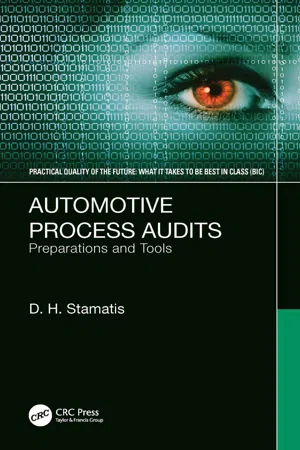
- 270 pages
- English
- ePUB (mobile friendly)
- Available on iOS & Android
About This Book
With a detailed discussion on the preparation and tools needed for an automotive process audit, this book addresses the fundamental issues and concerns by focusing on two objectives: explaining the methods and tools used in the process for the organization, and provide a reference or manual for dealing with documenting quality issues.
This book addresses the fundamental issues and concerns for a successful automotive process audit and details specifically how to prepare for it. It presents a complete assessment of what an organization must do to earn certification in ISO standards, industry standards, and customer-specific requirements. It also focuses on the efficiency of resources within an organization so that an audit can be successful and describes the methodologies to optimize the process by knowing what to do, what to say, and how to prove it. A road map is offered for the "process audit" and the "layered audit, " and defines a clear distinction between the preparation details for each.
This book is intended for those that conduct audits, those who are interested in auditing, and those who are being audited. It specifically addresses how to prepare for an automotive process audit for readers who are involved in quality, manufacturing, and operations management, and those who work with suppliers.
Frequently asked questions
Information
1 Introduction to International Quality Standards
Overview
- International Standard = 20,038
- Technical Report = 849
- Technical Specifications = 559
- Guide = 40
- Publicly Available Specifications = 28
- International Standardized Profile = 13
- International Workshop Agreement = 11
- Technology Trends Assessment = 5
- Recommendation = 1.
- Their quality matches expectations.
- They are fit for purpose.
- They meet the needs of their customers and ultimate users.
- Some form of standards is an essential element of any QMS.
- Ensuring safety and reliability of their products and services
- Complying with regulations, often at a lower cost
- Defining and controlling internal processes
- Meeting environmental objectives
- Meeting customer’s needs and expectations.
- Increase their profits
- Reduce losses or costs across the business (through less rejects and rework)
- Improve their competitiveness
- Gain market access across the world
- Increase consumer loyalty (due to consistent quality).
ISO 9001
GENERAL Comments
- Customer focus: The primary focus of quality management is to meet customer requirements and to strive to exceed customer expectations.
- Leadership: Leaders at all levels establish unity of purpose and direction and create conditions in which people are engaged in achieving the quality objectives of the organization.
- Engagement of people: It is essential for the organization that all people are competent, empowered, and engaged in delivering value. Competent, empowered, and engaged people throughout the organization enhance its capability to create value.
- Process approach: Consistent and predictable results are achieved more effectively and efficiently when activities are understood and managed as interrelated processes that function as a coherent system.
- Improvement: Successful organizations have an ongoing focus on improvement.
- Evidence-based decision-making: Decisions based on the analysis and evaluation of data and information are more likely to produce desired results.
- Relationship management: For sustained success, organizations manage their relationships with interested parties, such as suppliers.
- There is no requirement for a quality manual (however, highly recommended).
- Its emphasis on organizational context and risk-based thinking is of paramount importance.
- There is no requirement for the management representative. Now the leadership clause is more inclusive for the top management.
- The standard does not include a specific clause for “Preventive Actions.” Now preventive actions are sprinkled in the entire standard.
- The terms “document” and “records” have been replaced with the term “documented information.” Documented procedure in ISO 9001:2008 has been replaced by maintained documented information, and documented record in ISO 9001:2008 has been replaced by retained documented informat...
Table of contents
- Cover
- Half Title
- Series Page
- Title Page
- Copyright Page
- Dedication
- Table of Contents
- List of Figures
- List of Tables
- Preface
- Acknowledgments
- Author
- Introduction
- Chapter 1 Introduction to International Quality Standards
- Chapter 2 Industrial Standards/Requirements
- Chapter 3 Customer Specific
- Chapter 4 Documentation
- Chapter 5 Checklists
- References